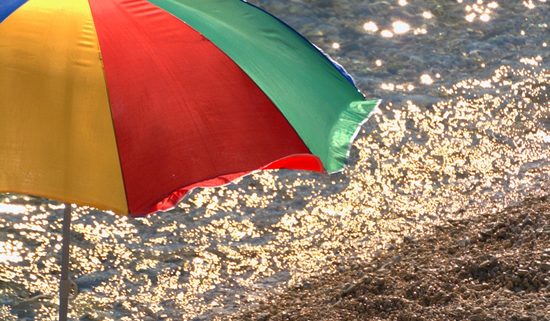Geopoložaj i klima
Prosječna temperatura površinskog sloja mora ispred Podstrane je 17,5 0 C. U zimskim mjesecima temperatura mora je između 12,5 i 13,0 C, a u toku ljeta između 23,0 i 26,0C.
U reljefu cjelokupnog područja Podstrane bitno se razlikuju tri paralelne morfološke cjeline: 1. vapnenačko bilo, 2. fliška padina i 3. obalska naplavina.
Najviši i najistaknutiji položaj ima kamenito vapnenačko bilo Peruna s prosječnom nadmorskom visinom od oko 450 m. Bilo Perun strmo pada oko 100-170 m prema jugozapadu i na pojedinim mjestima završava diluvijalnim siparima („točilima“ ) koji prekrivaju spoj sa susjednom fliškom padinom.
Eocenska fliška padina, kao druga morfološka cjelina ima u Podstrani najveću rasprostranjenost. Ona je blago nagnuta (u prosjeku oko 15 0) od siparišta na podnožju vapnenačkog bila do naplavina uz morsku obalu i donji tok rijeke Žrnovnice.
Priobalski reljef nastavlja se u podmorju Bračkog kanala. Dno do dubine od oko 30 m slijedi nagib fliške padine (oko 15 0), a zatim je vrlo blago nagnuto prema sredini kanala gdje samo na nekoliko mjesta prelazi dubinu od 50 m.
TLO I BILJNI POKROV
Pod utjecajem geološkog sastava, reljefa, klime i vegetacije na području Podstrane, sukladno trima geomorfološkim cjelinama, na svakoj od njih razvili su se i specifični tipovi tla. Vapnenac je podložan kemijskom otapanju pri čemu u pukotinama i šupljinama zaostaju neotopivi mineralni sastojci, tlo crvenica („terra rossa“). Kako je udio mineralne komponente u vapnencima relativno malen, svega 1-3% unatoč trajanju kemijskog rastvaranja od više desetaka tisuća godina u krškim pukotinama i šupljinama nakupilo se relativno malo crvenice. Ona je ipak dala podlogu za širenje vegetacijskog pokrova čijim su se posredovanjem na površini iznad crvenice razvili smeđe tlo i crnica.
U krajoliku strme padine vapnenačkog bila prevladava golet s niskim travama, aromatičnim grmljem i izdvojenim stablima alepskog bora (Pinus halepensis), dok je zaravan na vrhu bila kamenjar s niskim travama i zimzelenim grmljem. Ostaci hrastovih stabala u području stare Podstrane daju osnovu za zaključivanje da su prije naseljavanja ovog područja flišku padinu prekrivale šume hrasta medunca (dub, Querces pubescens). Uz bor, veoma je raspostranjena i samonikla brnistra ( Spartium Junceum).


